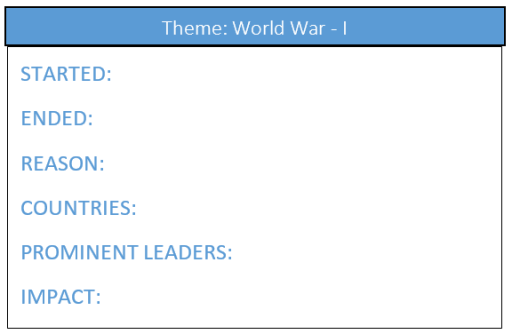One-to-Few: The Right Way Forward
Posted: March 14, 2016 Filed under: Teacher's Desk | Tags: Group tuitions, one-to-one tuitions, Personalized Teaching, teaching methods, Teaching Techniques, teaching tips Leave a comment“I need a teacher to provide personal attention to my child to ensure he learns well”
“My child needs to learn the following and I see that he is struggling a bit to do the same – Need your help on this”
We are sure while you read the above sentences, you were visualizing images of different parents who spoke the same words to you.
Now the real question is:
What does the student (or) a parent want from a teacher? Is it just personal attention to facilitate student learning?
(or)
Is it an achievement of the student’s learning outcome in an enjoyable learning environment? In simple words ‘Is the student learning and enjoying the way he/she learned things?’
I am sure there is no guidance required for anyone in picking the correct one from the above two questions.
It has been several years since the concept of ‘Individual Tutoring’ and ‘Group Tutoring’ gained popularity as extension avenues to everyday learning from the schools. But to us at vedantu, the questions are-
- Can One-on-One sessions provide an environment where students can collaborate?
- Can a group tuition ensure sufficient interaction time and attention span of the teacher with all students?
The solutions to these question lie in the fact that a great blend of offerings could enable a teacher handle both the above challenges effectively and make learning fun for the students.
One-to-Few – An offering where teacher handles just 3 to 7 students.
A blended model of teaching where the learning is personalized and gives enough room for each student to learn from his/her peers.
This calls for a detailed analysis of what this can do to the students and the teacher:
- Bonding within students and between the teacher and students is very strong
- This opens up room for the teacher to apply varied pedagogy
- Students have the opportunity to support and learn from each other
- Avenues for student interaction are more.
- Opportunity to provide personalized feedback still remains intact for the teacher
- Peer teaching and learning can be encouraged
- Teacher has the option to conduct group-based learning activities
- Content sharing/assessment evaluation happens in a controlled environment
Just awesome…Isn’t it? The new offering seamlessly handles a lot of learning and teaching challenges and yet offers interaction and blooming opportunities for students.
What do you think, don’t we see ANY challenges at all with this new offering to impart learning?
An honest answer would be – Yes, we do see some of them. The most common ones coming from teachers would be –
“As a teacher, I have varying levels of learners in the same batch”.
“I do not have enough time to interact with all students”
Though it seems that we should agree to the above challenges that teachers face, but with time and experience, we have understood that these challenges are only exclusive to unprepared teachers.
Now that we know the lacunae, let’s see how effectively we can handle them and explore a few ways to make the sessions awesome for both – the teacher and students
Do the Homework Right
Have a plan ready for each level of learner in your batch. Remember, these plans should ideally be the strategies that can be applied to learners in all your batches. These strategies can be broadly devised for three phases of your sessions- Pre-Session, In-Session & Post-Session. (These examples are just a few among the hundreds. It is just a question of exploring them)
For example, you can get to know the level of learners well before your session by asking them to fill a KWL chart

You can also get a hang of the student’s understanding of the concept taught by an Exit Ticket

You can additionally check the understanding of the entire group and individual students by asking them to create Concept cards/Theme Cards on the taught concept. The best part of this exercise is, students are allowed to create the listed parameters to cover the concept on their own, which they cannot do without going through the understanding of the concept and these tools can be used in all subjects as well.

Involve Multiple Intelligences
When a student can learn in different ways…Why teach them in one way?
Every student is different and unique are their learning abilities and adaptation to teaching styles. Some students grasp the concept well, just by verbal communication to them. Others understand well through images –Images & drawings. Whereas some are comfortable learning by doing various activities. Others may understand a concept well by practicing several worksheets. Also, it is a proven fact that students learn quickly and retain most concepts taught to them using multimedia.
Once a teacher makes sure that his/her session involves a blend of teaching tools and methodologies, catering to the aforesaid needs, the question of teaching effectiveness doesn’t even arises. The teaching is bound to be effective even for a set of students with varied learning levels.
Encourage Peer Learning through Collaborative Activities
It is a proven fact that students feel more comfortable to ask questions and express their lack of understanding on any concept with their peers. In a confined group with the same learning objectives, it is very easy to make students teach their fellow mates and learn from them as well. Remember, every student feels proud when given an opportunity to impart learning to his/her peers. They express well, collaborate and arrive at lateral outputs when given a chance to work as a team.
Customize Assessment Strategies
Work out a plan to customize your assignments and tests for students with the different pace of learning. Give a comprehension-level assignment for a slow learner, which would boost his/her confidence in learning the concept. Once the comprehension-level assignment is completed, the slow learner gains the confidence to go for the next level assignment and the teacher should encourage and ensure he/she completes the same as well.
Similarly, an application/synthesis-level assignment for a quick learner gives him/her opportunity to express the subject expertise and boosts creativity helping them move to the next level
Create Avenues for offline interaction
A WhatsApp group can do wonders to facilitate offline interaction between you and the students, as well as amongst the students of the batch. You can safely utilize the platform to introduce the peers, check their learning progress, and solve doubts or any other difficulties.
We are sure with slight modifications in your teaching style, your students can achieve oodles of confidence in the subject/topic taught and would add multi-fold to your teaching effectiveness.
Content and Pedagogy are directly proportional to the effectiveness if any One-to-Few session. It is your preparation, the plan and the genuine willingness to execute that creates all the difference.
Trust Us… at the End of the day… It is truly worth it…
This article is contributed by Dr. Sundar Rabindranathan
He is an educational consultant and trainer who has trained students & teachers in more than 300 schools throughout India. Sundar currently heads Teacher Management at Vedantu and likes to play badminton in his free time.
Making Group Learning Personalized & Interactive.
Posted: February 12, 2016 Filed under: Academics_AIR | Tags: Academic research, Group tuitions, Online Tutoring, teaching methods, Tuitions, Tutoring, WhatsApp Leave a commentWe, at Vedantu, have always been curious to do something new and better. So when One-to-Few (OTF) online batches were launched on Vedantu, we thought of finding the best ways to make it more meaningful and interactive for our students. One of the most engaging ways that we could think of, was making a group outside the class. This would be a kind of offline Vedantu group, where the students are still in touch with each other even if they are not in the class. After researching on what can be done to break the ice between the students and the teacher of a particular online OTF batch before the first class, we ran a student community building experiment using asynchronous interactions via a WhatsApp group. And lo, there we were. Creating our own WhatsApp experiment! we were sure it would work best in a small OTF group tuition where a focused group of 5 to 7 students learn in a common online classroom.

The reason we did not exceed this number by 5 to 7 was simple, we didn’t want the personalized interaction to be compromised in any way. From our experience it appears that when there are more than 7 participants, the learning outcomes are compromised and the learner satisfaction goes down. Smaller group sizes make this phenomenon less likely to occur.
In launching such batches we ensured that the students enrolled for a particular class be comfortable with each other from the very first online session on Vedantu, as they are new to each other. The teachers are also guided to be sensitive to different communication styles and behaviors for various cultures to be seen in a learning community.
Here are a couple of pointers we kept in mind for a successful group interaction and meaningful learning of the group in an online environment.
1. Start WhatsApp interactions well in advance!
 The course teacher creates a WhatsApp group a few days before the course starts. The teacher initiates the interaction by framing a simple activity for the learners to introduce themselves to the rest of the focused group, by writing one or two paragraphs about themselves, their interests, hobbies etc. The teacher then have students respond to at least two of their fellow course mates in the forum.
The course teacher creates a WhatsApp group a few days before the course starts. The teacher initiates the interaction by framing a simple activity for the learners to introduce themselves to the rest of the focused group, by writing one or two paragraphs about themselves, their interests, hobbies etc. The teacher then have students respond to at least two of their fellow course mates in the forum.
When learners feel connected, the barrier of the technological infrastructure comes down. Learners feel they are part of a community and establish a social presence. The social presence, which is an important & intangible dimension in an online ecosphere.
2. Highlight the Purpose!

It is vital to highlight the purpose of the group. This helps learners and their parents know that the WhatsApp group is a special group – A group that would help improve the learning outcomes of the entire online study group you are part of. Also, it is a great medium to stay connected with the teacher, fellow learners and understand their academic needs, anytime and anywhere.
3. Early contacts lasts long!

As soon as the the group is created, the course teacher ensures that he/she induces some interaction. We saw some really amazing work from the teachers to break the ice. It involved sharing ‘Question of the day’, ‘Thought for the day’ or a fun activity that engaged the entire group. Doing this early on really helped in ensuring that a bonding is created amongst the group members and learning became fun.
4. Profile pictures – Make it real

The admin of the group also encourages students to upload a profile pictures of themselves in the WhatsApp Group. Although it is not a compulsion, but having a profile picture helps putting a face to a name. We are sure you’ll agree, this minor change of putting across a picture helps building and strengthening personal connections multifold in a student community online.
5. Utilize the Group Better

The teacher, who is also the admin of the WhatsApp group, makes sure that it does not becomes a yet another place to chit chat, but also plays a key role in major announcements of online tests and assignments. It was observed that whenever a doubt was posted, not just the teacher, but fellow students do come ahead to clears the doubts. Here is where the magic happens and social connections get stronger with a whole new meaning. The key remains in striking the balance! Whenever it was possible, we ensured creating groups based on experiences and kept a healthy mix of experienced online students and first time online learners.
6. Be available at the need of the hour!

The teacher makes sure the concerns and questions of the students are resolved well in time. We observed, in most cases the doubts were peer-solved and the teacher remained a facilitator in the group. while this enhanced the peer learning amongst the students, teacher makes sure to go an extra mile to arrange for a one-to-one session for further doubt clarification. As a matter of fact, when a teacher is involved and supportive of his/her students, higher levels of learning outcomes are more likely to be achieved.
The entire exercise was so much fun and gave us some really great insights – How a small study group behaves, how the interaction amongst complete strangers can be achieved, and what enhances the personalization in a group of 5-7 students learning an academic topic. Overall it was a great learning experience for all of us. It also paved way to an awesome community at Vedantu – Our very own OTF student community!
Image Credits – Google Images
About the author:
Namo works with Vedantu as Product Research Manager and is a Physics enthusiast. In his free time he loves to explore new cuisines and restaurants.
